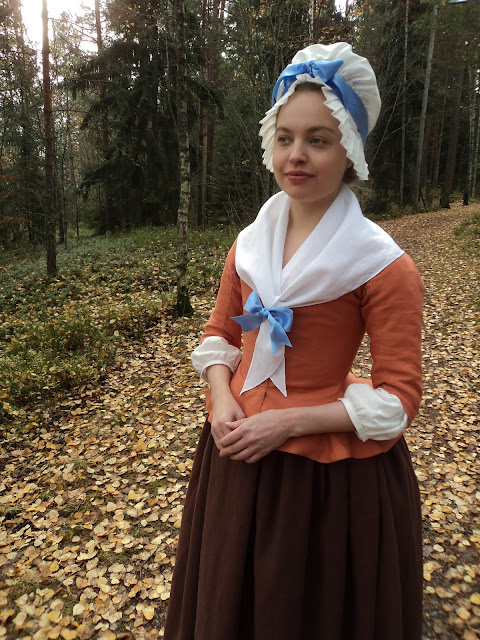 |
| Photo: neulansimanlapi.blogspot.fi |
Tiedättekö
sen kutinan kun tekee mieli ommella jotain nopeaa ja kohtalaisen
stressitöntä pelkästä ompelemisen ilosta? Tämä röijyksi 1700-luvulla
kutsuttu jakku valmistui pari viikkoa sitten, kun ruska oli
parhaimmillaan, mutta pääsimme kuvaamaan sen vasta tänään. Koska
kyseessä oli nk. stressinpurkuprojekti, päätin käyttää JP Ryanin tunnettua
1700-luvun jakkukaavaa kaavoituksen lähtökohtana. Kyseinen kaava on
siitä kätevä, että sen eri osia yhdistelemällä voi valmistaa erilaisia
jakkuja, jotka soveltuvat parhaiten vuosien 1760 - 1780-välille tarkoitettujen
asukokonaisuuksien osaksi. Jouduin lopulta muokkaamaan kaavaa
pienemmäksi (olisi ilmeisesti pitänyt valita pienempi koko), jotta sain jakusta itselleni istuvan. Loppujen lopuksi en
siis säästänyt aikaa käyttämällä valmiskaavaa, sillä samassa ajassa
olisin voinut yhtä hyvin kuositella koko jakun maallinuken päälle...
Are you familiar with the itching feeling when you long to sew something realtively stress free and quick? Well, I had that familiar feeling a couple of weeks ago, when I made this 18th century jacket, and we finally got around to photographing it today. Since this was ment to be a quick and relaxing project, I decided to use the well known JP Ryan's pattern for 18th century jackets as a starting point. The pattern is rather nice, since it alows you to mix and match different pattern pieces in order to create different styles to from the c. 1760's to 1780's. In the end, I had to adjust the pattern to fit me (I should have gone for a smaller size), so I could just as well have draped a similar pattern on my dress form in the same time it took me to copy and adjust the whole pattern...
 |
| Photo: neulansimanlapi.blogspot.fi |
Jakku
on ommeltu käsin pellavalangalla ajanmukaisin tekniikoin. Se koostuu
kahdesta etu-, sivu- ja takakappaleesta sekä hihoista. Vuori on
valkoista pellavapalttinaa. Jakun alla on uusi puhvihihainen pellava-aluspaita ja Diderot'n vuoden 1776 kaava mukaillen ommeltu kureliivi. Ruskea pellavahame on ikivanha, mutta totesin sen toimivan täydellisesti tämän uuden jakun kanssa, kun törmäsin tähän 1770-luvun lopun ranskalaista kokkia esittävään kuvaan. Puolihameen alla minulla on Paperinukke-projektiin tehty suomalaisen palvelustytön alushame ja "pyllytyyny" tuomassa asianmukaista muhkeutta. Jakku kiinnitetään edestä neuloin.
The
jacket is entirely hand-sewn with linen thread and period appropriate
stitches. It has two front-, side- and back pieces plus sleeves. I used
white plainwoven linen to line the jacket. I'm wearing my new shift that has longer puffed sleeves and my 1776's Diderot stays underneath the jacket. The brown linen petticoat is ancient, but when I came across this print depicting a french cook from the 1770's dressed in peach jacket, brown petticoat, and blue stockings I decided it was a perfect match. Underneath I'm wearing my Finnish maid's underpetticoat from my Paper Doll -project, and a bum-pad to add some appropriate oomhp. The jacket is closes with pins at the center front.
 |
| Photo: neulansilmanlapi.blogspot.fi |
 |
| Photo: neulansilmanlapi.blogspot.fi |
 |
| Photo: neulansilmanlapi.blogspot.fi |
En malttanut olla laittamatta uusia American Duchessilta tilaamiani kenkiä jalkaani, vaikka niiden säihkyvät soljet olivat ehkä liian hienot asun arkisuuteen nähden...
I couldn't resist wearing my new shoes from American Duchess for this photo shoot, even though the blingy buckles made them a bit too fancy for the rest of the outfit....
 |
| Photo: neulansilmanlapi.blogspot.fi |
Ihanat saumat!
The lovely seams!
Ehkä kaikkein ihastuttavinta 1700-luvun vaatteiden valmistamisessa ovat aikakauden saumarakenteet. Voisin jaaritella niiden nerokkuudesta ikuisuuden, mutta annetaan kuvien puhua. Alla olevat prosessikuvat ovat eräästä
toisesta projektista, jossa saumojen rakenne on sama kuin tässä
persikanvärisessä röijyssä.
Perhaps the most appealing thing about 18th century dressmaking are the seaming and stitching techniques of the era. I could go on and on about the ingenoius ways they used to stitch things together, but I'll let the pictures do the talking this time. The making of pics undearneath are from a different project that had similar seam-structures as this new peach jacket.
Sauma rakentuu seuraavasti: kuvassa alle jäävät päälli- ja vuorikangas, joiden päälle toisen puolen päällikangas taitetaan...
The seams are made accordingly: in the image you can see, that the right side fashion fabric is folded and placed over the fashion fabric and the lining on the left.
 |
| Photo: neulansilmanlapi.blogspot.fi |
Palat kiinnitetään toisiinsa pienen jaksotetuin takapistoin, jotka näyttävät tältä oikealta puolelta katsottuna.
The pieces are sewn together with tiny spaced back-stitches that look like this when viewed from the right side.
Tältä sauma näyttää ennen toisen puolen vuorikankaan kiinnittämistä.
This is what the seam looks like before you attach the other part of the lining.
 |
| Photo: neulansilmanlapi.blogspot.fi |
Seuraavassa vaiheessa toinen vuoripuoli taitetaan...
Next, the edge of the other side of the lining is folded under...
 |
| Photo: neulansilmanlapi.blogspot.fi |
... ja ommellaan jo ensimmäisessä vaiheessa kiinnitettyyn vuorikankaaseen niin, että takapistosauman raja ei jää näkyviin.
...and sewn to the other part of the lining to hide the back-stitched seam.
 |
| Photo: neluansilmanlapi.blogspot.fi |
Reunat on huoliteltu pistolla joka tunnetaan ranskankielisellä nimellä le point à rabattre sous la main. Tämä ovela pisto näyttää oikealta puolelta tarkasteltuna etupistolta ja nurjalta puolelta luotospistolta, mutta onkin niiden yhdistelmä.
The edges were neatened with what is known as le point à rabattre sous la main. This clever stitch looks like a running stitch when you view it form the right side and like a hemming stitch from the reverse side, but it's actually a kind of a combination of the two.
 |
| Le point à rabattre sous la main. Photo: neulansilmanlapi.blogspot.fi |
 |
| Le point à rabattre sous la main. Photo: neulansilmanlapi.blogspot.fi |
 |
| Photo: neulansilmanlapi.blogspot.fi |
 |
| Photo: neulansilmanlapi.blogspot.fi |
Edit. Diderot'n kureliivin vuosiluvun korjaus vuodesta 1769 vuoteen 1776. The date of pattern for Diderot's stays has been corrected from 1769 to 1776.

No comments:
Post a Comment